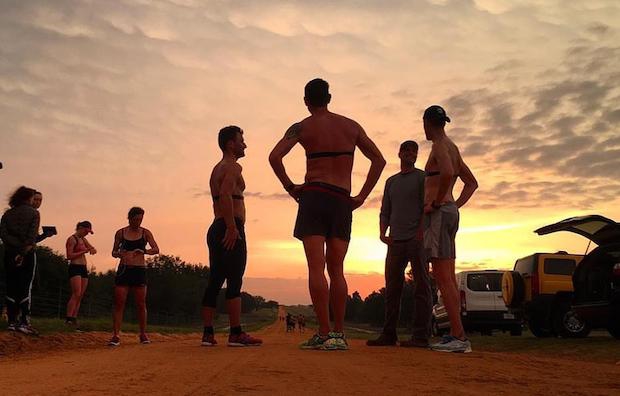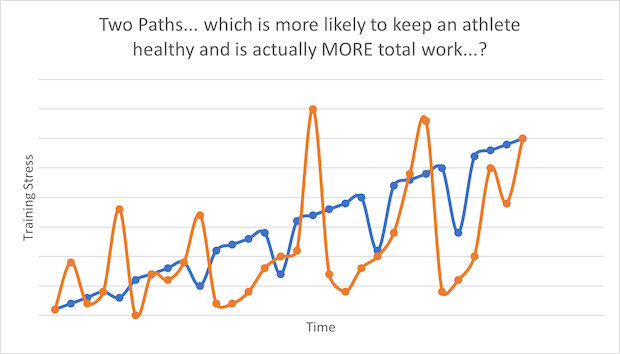The Best Way to Train? It Depends.

Since this is my first article, I feel as if I should start with a description about my overall approach to training. I’ll get into more specific topics in subsequent articles.
Let’s cut right to the chase: Nobody has the one true exact right training style. If they claim to, they’re either ignorant, or marketers whose only goal is moving money from your bank account into theirs.
The truth is that there is no one right and correct way to train or race. There is essentially nothing in the way of legitimate peer-reviewed studies with large sample sizes on how best to prepare for and execute a triathlon. Yes, there are studies that can be applied to various aspects of triathlon (“dehydration is bad!”, “being aerodynamic on the bike is good!”), but nothing truly comprehensive that can tie everything together. As triathletes, we’re all kind of our own little science experiments, learning much of what we collectively know through iterative approaches.
This has led to a world where athletes have often won world titles with seemingly very different approaches, which is fine. The problem that arises is that many people then think the current world champion has figured out the secret workouts that make you a champion. You see this play out often on the forums on this very website. Someone will make a post about the training logs of a successful athlete, and then a bandwagon forms thinking it’s THE way to train.
The latest craze is over Gustav Iden and Molly Seidel and their relatively low-intensity run training. Now I have people texting me to ask if they should run slow all of the time. A few years ago, age groupers thought Sami Inkinen had the magic bullet because his volume was very low for Ironman (like 10 hours per week) but the intensity was HIGH, and I had people asking me if they should only do high-intensity work. A few years before that, everyone was agog with Brett Sutton having his stable of dominant female athletes do massive sessions like “go run a marathon on the track, alternating 400s at IM race pace and 400s at an easy jog.” (I don’t know if that was an actual session, but you believed me when I wrote it, right? Point made.)
So as the PETA-friendly version of the saying goes, there’s more than one way to peel a potato when it comes to training strategies. But, there is ONE common thread that connects every successful athlete in how they train and race: they achieve consistency in their training. Now, consistency is a funny and loaded term. It seems simple, right? I mean, sure, I guess it is simple if you want to look at it as a general concept, but it is extremely NOT easy to accomplish (“simple but not easy” is possibly the defining phrase of triathlon). Consistency requires finding a training schedule that has you training at least 4 days per week on a long-term basis; obviously pros and “Kona level amateurs” are going to be training 6-7 days per week, but they’re not the only ones who do this wonderful sport. You’re not achieving consistency if it’s a schedule you only stick to for a couple months. Consistency is only consistency if you can stick to it month after month, and year after year. So what are the key requirements of such a schedule?

-places sport-sport specific stress on your body and mind
-allows recovery time to adapt to the training stress
-allows enough time between sessions and incorporates the necessary blend of activities required to STAY HEALTHY (sleep, soft-tissue therapy, nutrition, mental breaks, etc…)
-does NOT interfere with life at a level that causes significant strain in an important relationship in your life (whether that’s with a spouse, child, significant other, parent, employer, etc…)
Now this is where things get interesting and I’m willing to engage in a meaningful discussion on how to approach training strategies. In an ideal situation, you put your body through as much training stress it can handle while not pushing those other areas (health, recovery, relationships) into dangerous territory.
Circling back to current cause célèbres, Iden and Seidel… is their low intensity focus a good idea? Sure, but if and only if you can stay healthy doing it AND have enough time that you can allot to it. If you can allot 20+ hours per week to low intensity training, then it can be extremely effective. But if you can only allot 9 hours per week to training, low intensity isn’t going to do a whole lot for you. I mean, it’ll be great for your health, but you’re not really going to see high performance on race day (which brings us to another topic for another day… performing at an elite level in triathlon is not a particularly “healthy” lifestyle by many measures.) If you only have 9 hours per week that you can consistently devote to training, then a high percentage of that had better be at tempo or harder intensity if you want to see any sort of results on race day.
So where does this lead us? It leads us to what the most important training metric is. It’s not volume or intensity, but rather stress, which is generally considered to be a combined metric that considers both volume and intensity. Jesse Kropelnicki used to describe it as “how much oxygen you’re passing through your system.” We never directly measured that, but the concept of it is useful. TrainingPeaks has managed to assign a numerical value to stress with their TSS, ATL, and CTL metrics. I don’t use those a ton, but that’s just personal preference. I don’t have anything inherently against them, I just gauge the stress on my athletes’ systems in other ways (ability to hit workout targets, HR lag on intensity changes, overall mood, and motivation levels being the primary things I look at). One of the ways we control for this at QT2 is that we increase training stress by increasing volume or intensity in a given week, but not both simultaneously (of course there are exceptions to this rule, but in general that’s how we operate).
How do we turn this into real-world practical advice? First, set your logistical constraints: figure out what you cannot compromise on. In my world, you cannot compromise on your job, your family, or your sleep. If I find out one of my athletes is only sleeping 6 hours per night, I will cut down their training as far as is necessary to allow them to get 7+ hours per night. I’ve done this countless times, and it’s created real tension with athletes who think I’m too much of a sleep dictator. Well… too bad, right? That’s just how important I think it is. And if you can’t organize your life so that you get at least 7 hours per night, then you’re not living in an environment where high-performance and long-term health are simultaneously achievable, and I don’t want to enable anyone going down that path. After that, figure out what you can compromise on sometimes, and what in your life you wouldn’t mind eliminating completely. Once that is done, we have an idea of what a realistic training volume is. Not necessarily the volume you should be doing right now, but what the ceiling is for your biggest weeks.
Once you have the volume that’s logistically achievable, then THAT’S when you start talking about intensity distributions. We’ll base target intensity distributions on what an athlete’s priority race for the year is, and what their limiters are for that specific race distance/terrain (really digging into the particulars of this could be an entire book, so I’m just gonna leave it there for now…).
So am I willing to talk to you about training strategies and intensity distributions? Sure. But you’d better enter the conversation knowing that it’s about a LOT more than just “I need to train short and hard!” or “I need to train long and slow!” Nothing you do in training matters even a little bit if you aren’t achieving consistency. The real conversation is “I have X amount of hours available. What is the most amount of training stress I can fit into that without risking consistency, or making compromises on health or other important areas of my life?” I’m not interested in chasing fads. I’m interested in keeping people grounded in the fundamentals and keeping them healthy, while also subjecting them to systematic increases in training stress. If you do that, the speed development will take care of itself. Everything else is just details.
Doug MacLean is a USAT Level 2 coach who has been working for QT2 Systems since 2010. In past lives, he was a D-1 college rower, a Surface Warfare Officer in the US Navy, and a professional triathlete for 8 years. He currently lives in Boston, MA with some humans and a Stage 5 Clinger wheaten terrier.

